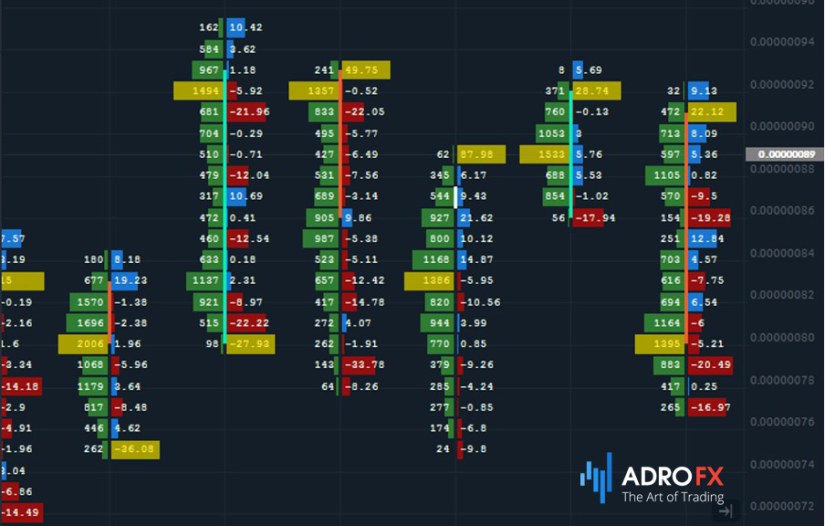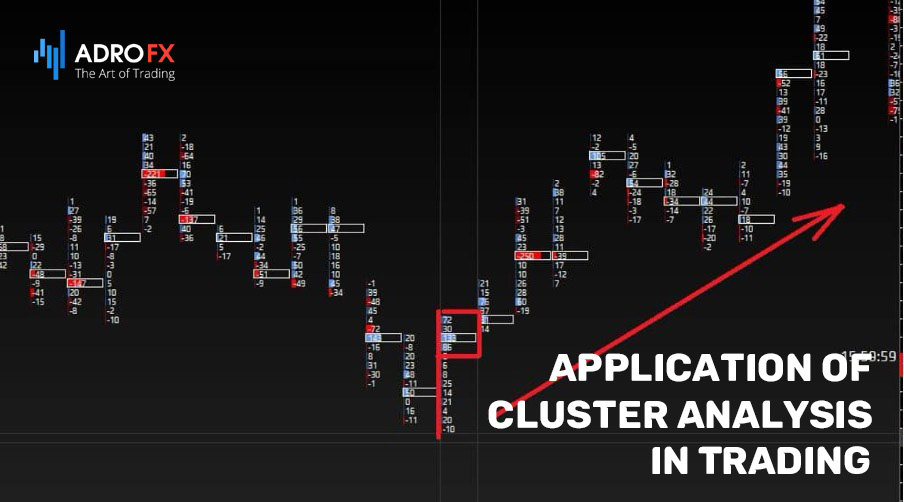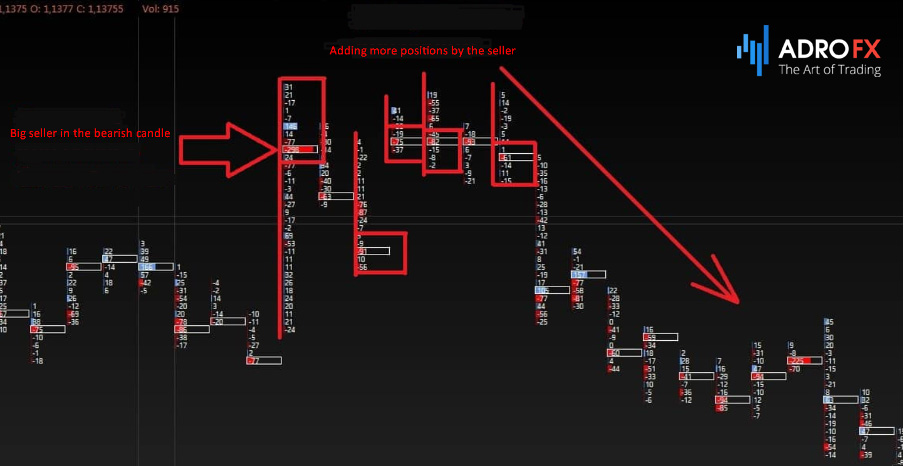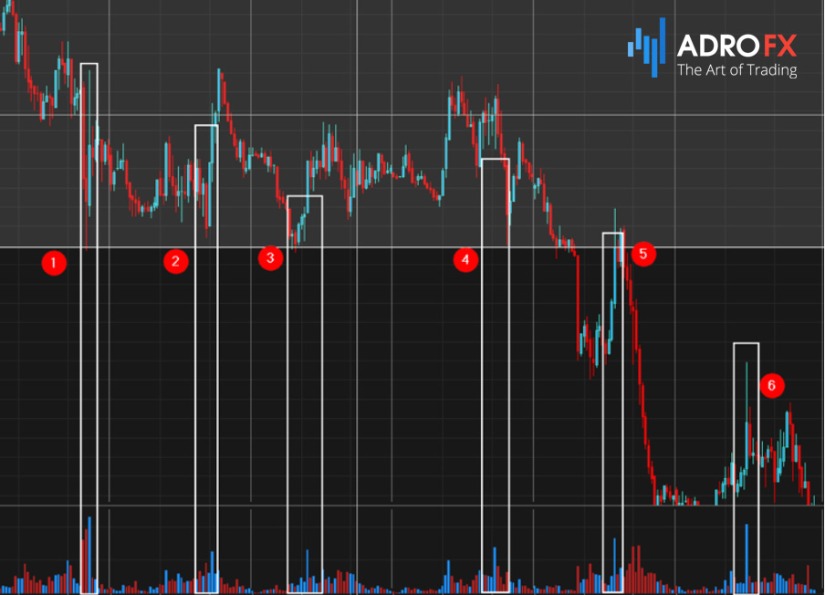The Ultimate Guide to Cluster Analysis

Cluster analysis is a very useful tool that allows you to find the best points to enter the market, thus increasing the efficiency of the trader. Someone hears about it for the first time, for someone it is familiar but incomprehensible. It can be used to understand how the real picture of the market is presented and what ratio is observed between the buyers and sellers.
In this article, we will provide an insight into the cluster analysis, learning in detail what it is and how to apply it competently in trading on the financial markets.
Briefly About the Market Profile
Before we move to clusters, we first need to understand the market profile. This term means data on the volume of contracts that were executed at a particular price level. If we speak about the forex tick volume, then we consider only this data and do not pay attention to the real orders flow.
An example of a market profile can look as shown in the picture below:

Cluster analysis is also a volume profile, but for each specific candlestick or tick, where a specific number of trades made is indicated. This phenomenon can be compared to the graphical interpretation of the Depth of the Market, but the volume in this case is incomplete.
Tools for Cluster Analysis
There are very few options to use cluster analysis for free, and most of the options are trial versions for up to two weeks or very primitive and illiterate functionality.
Among the top options for cluster analysis are the following:
- Volfix – the most popular option for a wide audience of traders, particularly those with experience. The fee is $60 per month;
- Ninja Trader – you pay $225 quarterly and use the cluster analysis functionality;
- CluterDelta – usage services are priced at $7.5 per month;
- SBPro – a convenient option to save funds as the trader makes a one-time payment of $100.
In the functionality of MT4 terminals, there are not only paid but also free access versions of volumetric indicators and market profiles. There are such popular tools:
- ClusterDelta – you pay a monthly fee of $7.5;
- YuClusters and YuClusters Demo – paid and free versions of the program, respectively;
- QScalp – scalper drive with elements of cluster analysis;
- TPO-v3 – this indicator is available for free;
- HighVolumeBar-VerticalHistogram-v2 – free for traders.
What is a Cluster in the Financial Market?
Joseph Granville once said that volume is the amount of steam that allows a steam locomotive to move. An analogy with the foreign exchange market can be drawn here. Many traders today focus their attention on trading volumes and their interpretation to calculate future price movements. This is relevant to everyone – both those who trade in the short term and those who prefer long-term positions. It is the cluster analysis that helps to work in the volume of the market.
By cluster, we mean the union of several similar or identical elements, which form an independent unit with specific properties. We are trading on the market, we are concentrating within a certain time frame, and at the same time, homogeneous elements in the form of long and short positions with assets will appear at certain prices. Summing up such elements, we obtain clusters - the total volumes of purchases and sales of currency pairs, taking into account a certain time frame and price parameters.
The cluster analysis is aimed at studying such orders and their volumes inherent to certain price levels, and the trader will be able to understand in more detail in which direction the target asset is most likely to move.
To visualize this type of analysis, a special chart is used when a trading volume is superimposed on the candlestick of each price level.
The figure below shows what a cluster chart looks like:

If we refer to the QUIK terminal, we can find an impersonal table of all performed transactions, and the trader can display the data for the asset of interest to them. This table combines all current orders and their volumes. It is a question of active trades, as there is always a spread between the best price value for buying and selling in the stack. To execute a trade, one of the counterparties must agree to the price offered by the opponent. All these transactions go into the table of impersonal trades, known as Ribbon.
It is important to take into account the fact that in the case of a successful trade, we have two active subjects that form the trading volume: on the one side is the initiator, and on the other - the counterparty, which provided this volume. The data of such trades will get to the cluster chart, and the trader can get even more accurate data and important details about how the candlesticks are formed and what happens at such moments.
And what happens at the moment of drawing the next bar on the chart? Let's find out. First, all the applications are divided into two groups:
- from professionals – these are huge amounts of capital;
- from small traders – much smaller volumes.
The clusters clearly show how the influential market players behave - they are oriented to buy or sell, and what prices are relevant to them. All data on positions is formed in the corresponding cluster. If on the same candlestick there are trades with the same prices from different traders, all the volumes are summarized in one cluster and the trader gets the actual figures of the analysis.
In the cluster analysis system, the main concepts that are important to know and be able to apply are the following:
- market delta (delta);
- market profile.
Let's look at each of them separately.
What is a Market Delta?
The delta is expressed as the difference between the active buy and sell orders in a certain time frame. If it is positive, we can state that the candlestick was dominated by buy trades, while if the delta is negative it means that sell trades prevail.
When the number of buy orders is higher, it usually is accompanied by a price increase, and the superiority of sell orders indicates a further price decrease. If you keep track of all the buy and sell volumes plotted on a candlestick, you can tell the difference in the number of transactions. The trader will be able to see for himself which side was dominant on the candlestick of interest. The resulting difference as a delta should be understood in the general context of other bars. Therefore, we can conclude that the price will go up when long positions dominate, and the price will go down when short positions prevail.
What is a Market Profile?
The market profile refers to trade volumes of transactions corresponding to each specific price, on one day or over the entire period under analysis. Thus, this is a "vertical" type of volume, and it qualitatively shows the levels, at which the largest volume was fixed during the time interval. If this zone is broken out in the opposite direction, it threatens to trigger stops, hence momentum will appear.
The market profile helps to trace the key levels and interpret them as areas of maximum trade volumes. Also, through this concept, we can understand at what levels what volumes on the orders were tracked.
Application of Cluster Analysis in Trading
Clusters can be applied differently, depending on what method of construction is used by the trader. The following are considered the most effective:
Delta profile - is considered the most convenient and informative method, which shows the presence of the most influential buyer or seller on a particular candlestick. In this case, the difference between bullish and bearish volumes is calculated;
Cluster-profile - shows the total trading volumes on a candlestick, in which the trader can observe only the fact of activity, but does not know who the initiator is.
The highest efficiency of both methods is observed for time frames of less than 30 minutes, and the situation may not be predictable in high time frames.
All values from the Ribbon go straight to the chart of the cluster analysis. The following patterns are considered:
P - the concentration of positive delta at the top of the bar, and there will be very few trades under it. This is the generation of a bullish reversal signal;

b - there is a concentrated stream of sales in the lower part of the bar, while the upper part of the candle is calm. This is a bearish signal generation.
It is important to monitor not only the pattern but the delta as a whole, otherwise, the picture will be ambiguous, as demonstrated in the image below.

If you look only at the candlestick chart, the trader has little such information and the chart would simply reach the level. Such a situation can be seen as both a reversal and a continuation of the trend, as seen below in the chart.
Thanks to the delta profile trader refrains from buying and finds the perfect moment to sell.
Analysis by the Cluster-Profile Method
When analyzing the market using this technique, it is important for the trader to find large volume data. If a level is formed, it will be held by bulls or bears, depending on the strength of the market, and for us, it is an opportunity to place an order with the least risk.
It is important to consider several points of contention here:
- it is not clear why a big player decides to buy an asset at the same price if it is possible to place orders at several quotes of one range;
- the price behavior is often unpredictable in relation to large volumes, so the idea may not work;
- if large orders are sent to the opposite movement, it makes it easy to manipulate traders.
Peculiarities of Cluster Analysis in the MT4 Terminal
If the volume is higher than the average value, it will be highlighted in color. It is convenient for the visual perception of data by a trader.
The trader can determine not only the delta but also the beginning of a strong movement and its direction in a point form.
To calculate the pivot level we need the values of such parameters as:
- histogram with volumes of each candle;
- graph of clusters by point volumes;
- market profile, i.e. trading volumes of each price level.
Using all information in complex, it is possible to create one's own trading strategies and supplement them with auxiliary tools.
The cluster analysis allows you to monitor the activity of market participants, in particular the largest ones, in order to track the volumes on the price bars. This method can be safely called the most accurate and detailed in the work of the trader.
The key task of the trader is to calculate the moment of delta transition from the moderate value to the normal one when the market goes from flat to trend. The following example serves to illustrate this:
- Let's take a combination of these assets – EUR/GBP+GBP/USD+EUR/USD;
- Let's assume that the EUR/USD exchange rate has risen, while GBP/USD has not changed;
- Then EUR/GBP will also strengthen due to the interrelation of all three pairs;
- If one currency pair changes, the positions of the other two pairs will also change.
The YuClusters indicator is useful, as it helps to generate charts using tick data and the trader's selected Ask, Bid, or average price.
Spot Inflow in Cluster Analysis
The essence of this technique is to identify levels that are characterized by high volumes, which correspond to the actions of large players to enter a trade or to close an order.
Spot volume is a zone of increased liquidity inflow into the market. However, each asset and time frame has its own value in the cluster that can be informative and effective for further analysis.
Other important influencing factors are the trading session and the general market activity.
Volumes, which should be taken into account during the cluster analysis, are indicators belonging to the local trends and turning points:
Level 1 - the formation occurred on the hairpin of a large volume. It is possible to put forward the assumption that some large participant opened a short position or fixed the trade, i.e. completed a long position;
Level 2 - the price met with the resistance of a high volume, it is possible that at this moment the participant filled the position in the analyzed area;
Level 3 - the inflow volume turned into a resistance level for further price movement;
Level 4 - when there was an impulse breakout of the local bottom and then a pullback, another level appeared, which presumably was used to place sell orders at advantageous corrective prices;
Level 5 - positions have been added following the trend when a breakout of the local extremum has occurred.
To determine more accurate levels it is necessary to analyze the lower time frames, including looking at the data of the M1.
Vertical Trading Volume
This is a histogram, which shows data on the volume of traded positions and their correspondence to each candlestick.
When this kind of analysis is carried out, it is necessary to look for the moments when the liquidity surge occurred and at what level it happened:
- level breakout;
- the rebound from the key point.
Examining the figure, we can note that the bars of the histogram 1-4 show how a rebound from a support level occurred on a strong inflow of volume. The area of bars 5-6 shows that the rebound in volume slowed down the upward movement, and a large trader entered into selling trades.

Horizontal Trading Volume
This approach serves as an effective way to study the market and determine the levels of influence, and find the points of potential reversals. It is also called a market profile and is depicted as a histogram indicating the data of the traded volume at each market segment.
When the market profile is generated, you should indicate the specific area to be examined - day, week, etc. The time frame is set individually by the trader, as it depends on their trading system.
In the chart below, you can see the horizontal volume, which helps to get signals about the local key levels within the cluster analysis.
Conclusion
Cluster analysis of the market allows for determining the moments of increased trading activity in the form of volume data, where large market players gained their positions. It belongs to the category of modern and highly accurate forecasting methods because it is based on the detailing of incoming volumes in an asset.
About AdroFx
Established in 2018, AdroFx is known for its high technology and its ability to deliver high-quality brokerage services in more than 200 countries around the world. AdroFx makes every effort to keep its customers satisfied and to meet all the trading needs of any trader. With the five types of trading accounts, we have all it takes to fit any traders` needs and styles. The company provides access to 115+ trading instruments, including currencies, metals, stocks, and cryptocurrencies, which make it possible to make the most out of trading on the financial markets. Considering all the above, AdroFx is the perfect variant for anyone who doesn't settle for less than the best.









